Epiphyllum: home care and breeding examples
Content:
Epiphyllum, or forest cactus, is a succulent plant native to the countries of the tropical zone, Mexico and Central America. The plant belongs to the Epiphytic cactus family, but differs from the usual cacti in the form of a shrub with leaf-shaped stems.
Epiphyllum types
Epiphyllum is a flower that takes root easily at home. It pleases lovers of home plants with abundant flowering 1-2 times a year. The stems of the plant are similar to yellow-green leaves with a jagged edge and spines at the edges.
The color range is extensive, includes shades: cream, pink, white, red, yellow, orange.
Anguliger
Epiphyllum of the Anguliger cultivar means "angular", its stems are yellow-green in color, profusely branching at the base. It is distinguished by deep articulations that divide the stems into rounded segments. Both in the wild and at home, the plant often forms aerial roots. Flowers reach 10-20 cm in length and 5-8 cm in width, have a white color, open in the evening and at night, have a pleasant aroma.
Ackermann
Epiphyllum of the Ackerman variety is distinguished by its decorative effect, has a triangular stem shape with teeth at the edges. At home, the stem can be up to 5 cm wide and 60 cm long. The flower grows up to 15 cm in diameter, the epiphyllum has a red tint, it can be painted white or yellow.
Oxypetalum
Epiphyllum of the Oxypetalum variety, or ostrolepetal, is the most commonly cultivated species. Its other name is "Queen of the Night". It has a wavy edge of the stem without thorns, it can reach 2-3 meters in height. The size of the flower reaches 17-19 cm in diameter, blooms at night, has a strong sweet aroma.
Guatemalan
The epiphyllum of the Guatemalan variety is a cactus that differs from other varieties in the structure of its stem. It either consists of links up to 5 cm long, the shape of which resembles an oak leaf, or has an arbitrary shape. The flowers are small in size, the epiphyllum has a pink tint.
Other
At home, cacti of natural origin are grown, there are about 20 varieties or hybrid species of which there are about 200. Among indoor plants are often found:
- Epiphyllum of the Marniera variety. Has a wavy edge of the stem, on which buds appear. Flowering begins at the end of winter, the buds are colored yellow, red, orange, white and pink;
- A variety called Lau, on its stems needles grow up to 5 mm in length. Cream-colored buds open in the evenings and bloom for up to 2 days, have a fragrant aroma;
- Epiphyllum Paul de Lonpre - a variety that has a small root system, you can choose a small pot for planting it;
- Just Prue cactus is a hybrid variety that propagates by cuttings. The bright pink color of the flower with a dark edge is a distinctive feature of this variety;
- Epiphyllum of the Phyllanthus variety can produce both single and multiple buds of a delicate pink shade with a yellow-white core;
- The cactus epiphyllum serrated has a large number of shoots, its buds open in the dark.
Home epiphyllum care
Caring for the plant from the moment of planting is divided into the period of rooting of the plant and the maintenance of the necessary growth conditions. For a cactus, it is important to have sufficient lighting and maintain the temperature within the range of 20-25 ° C.
In summer, the epiphyllum can be outdoors. After flowering, the flowerpot with the plant can be taken out into the street and dug in the ground, for this you should choose places without strong drafts.
Rooting a cactus
Initially, the plant is placed in a small pot; as it grows, it is transplanted into a larger vessel. In order for a cactus to take root and take root, it is important to follow all planting rules. It needs a substrate for cacti, drainage and a plant with roots. How to plant correctly:
- Place a drainage layer 4-5 cm thick at the bottom of the pot;
- Pour 6-7 cm of substrate over the drainage and place the plant in the middle, straighten the roots;
- Fill the voids on the sides of the cactus with soil. You need to knock on the pot with your palm so that excess air comes out, and the earth crumples.
Soil and fertilizing
For cacti, a neutral or slightly acidic environment is needed, the soil must be loose to ensure air exchange. Epiphyllums are planted in a special substrate for cacti, which is sold in the store. You can also make a suitable composition yourself, for this you need:
- Fibrous sod soil - 200 g;
- Leafy soil - 200 g;
- Fine charcoal - 50 g;
- Coarse sand, preferably river sand - 50 g;
- Peat - 50 g.
In spring and summer, the plant is fed every 2 weeks with fertilizer for cacti. It is necessary to reduce the dosage indicated on the package by 2 times. After the formation of buds, a mixture of water and mullein in a ratio of 4: 1 is used for feeding. After the plant has bloomed, you can alternate feeding with mullein and fertilizers until the end of summer.
Air humidity
To maintain the epiphyllum, it is not necessary to maintain a certain air humidity. Additional humidification is required in the hot season, when the air temperature exceeds 25 ° C. To do this, you can spray the stems of the plant or wipe them with a damp cloth, if their shape allows. In the cold season, the amount of irrigation is reduced to 1 time per month or stopped altogether.
Watering
Despite the fact that the epiphyllum belongs to the Cactus family, it requires abundant watering. It is necessary to water it when the top layer of soil in the pot dries up, no more than 2-3 times during a month.
You can use only settled water, without chlorine impurities, it should be at room temperature. The flower pot should stand on a tray into which excess water will drain.
If the plant is in a cool place, in the autumn-winter period, watering can be suspended or reduced to 1 time per month. At the beginning of spring, watering is gradually resumed, it is impossible to abruptly return to the previous schedule, the amount of water is gradually increased. You can start with 1 watering every 2-3 weeks.
Flowering epiphyllum
Each plant variety blooms differently, has its own time for flowering. Epiphyllum white and red can differ not only in color, but also in the shape, smell and size of the flower. In order for the plant to bloom, the pot must be on the windowsill on the east or west side. During the summer, the cactus can be outdoors, but direct sunlight should be avoided.
Flowers bloom in turn, each blooming from a few days to a week. Flowering begins in the spring, usually in mid-April, but some species of phyllocactus bloom again in the fall.
Reasons why it does not bloom
If a plant is improperly cared for, it may stop blooming. Failure to comply with the temperature regime, lack or excess of moisture affect the forest cactus. Why epiphyllum has not bloomed for a long time:
- Excessively high air temperature during wintering;
- Excess nitrogen in the planting soil;
- Insufficient watering during the hot season;
- Excess watering in winter;
- Lack of lighting;
- The presence of fungal diseases in the plant.
Ways to make bloom
A cactus can only bloom if it grows in a favorable environment. It makes no sense to force a plant to bloom if it is in the wrong conditions. If the flowers have not been available for long enough, most likely, the rules of plant care have been violated.
How to make epiphyllum bloom:
- Check the amount of moisture. Humidity should not be elevated, and the plant should not be in dry ground;
- Provide sufficiently bright diffused lighting. If the flower stands on the windowsill from the north side, and there is no opportunity to place it in the west or east, it is necessary to move it as close to the window as possible;
- Introduce top dressing, if this has not been done for a long time;
- Check the composition of the fertilizer used for the presence of nitrogen. Fertilizers may be preventing flowering;
- Provide the plant with a dormant period, place it in a cool room during the winter;
- Trim old woody shoots and stems;
- Remove trihedral shoots, flowers rarely form on them;
- In early spring, you can spray the cactus with warm water from a spray bottle. Many gardeners use this method to help the plant "wake up", soon thickenings appear on the stems - future buds;
- Check plant stems for blotches or outgrowths. It is possible that the cactus is affected by a fungus that slows down its growth and interferes with flowering.
Epiphyllum propagation methods
Reproduction by cuttings and seeds is characteristic of the epiphyllum, each method has advantages and disadvantages.
Seeds
Epiphyllum can be grown from seed, which will require:
- Seeds;
- A pot with low sides;
- Substrate for cacti and succulents;
- Glass or polyethylene;
- Drainage (pebbles, polystyrene);
- Scapula.
How to grow:
- Drainage is laid out on the bottom of the pot in 1 layer, 3-4 cm of the substrate is poured over it. Everything is abundantly irrigated with water;
- Seeds are evenly laid out on top, they need to be sprinkled with a small amount of substrate. They should be 5-6 mm deep;
- The pot is covered with plastic wrap or glass. It should stand in a well-lit place at a temperature of 20-25 ° C;
- Every day, the crops must be ventilated by opening the glass or film for 45-50 minutes. After 2-3 weeks, the protective layer is removed;
- The sprouts can be transplanted into separate pots when they are 4-5 mm in length.
The substrate with seeds should always be moist, for this it is irrigated with water from a spray bottle. Over time, the stems acquire a flat shape, the plants grown from seeds will bloom only after 5 years.
Cuttings
Epiphyllum cactus is propagated by cuttings from mid-April to early May, what you need to do:
- Cut off the end of any stem with a length of 5-10 cm. If the width of the cutting is more than 5 cm, it must be done already towards the base. Its width should be within 3-5 cm;
- The stalk should dry out at room temperature, for this it is placed on a blank sheet of paper and left for 1-2 days;
- A drainage layer is laid at the bottom of the pot, earth is poured on top;
- The shoot is planted in prepared moist soil to a depth of 5-7 mm. If it is unstable, you should tie the stem to a peg.
The first day after planting, the shoot is not watered, it should be in the shade. After 2-3 weeks, roots are formed, all this time the soil should be moist, without excess dampness. The cuttings are looked after as if they were an adult flower; in 1-2 years the epiphyllum will bloom.
Many plant lovers choose epiphyllum for their home, caring for this plant at home does not require a lot of time and resources. It is called "Cactus-orchid", epiphyllum flowers have different shapes and sizes, differ in color. If the cactus is properly cared for, every year it will delight with abundant flowering.
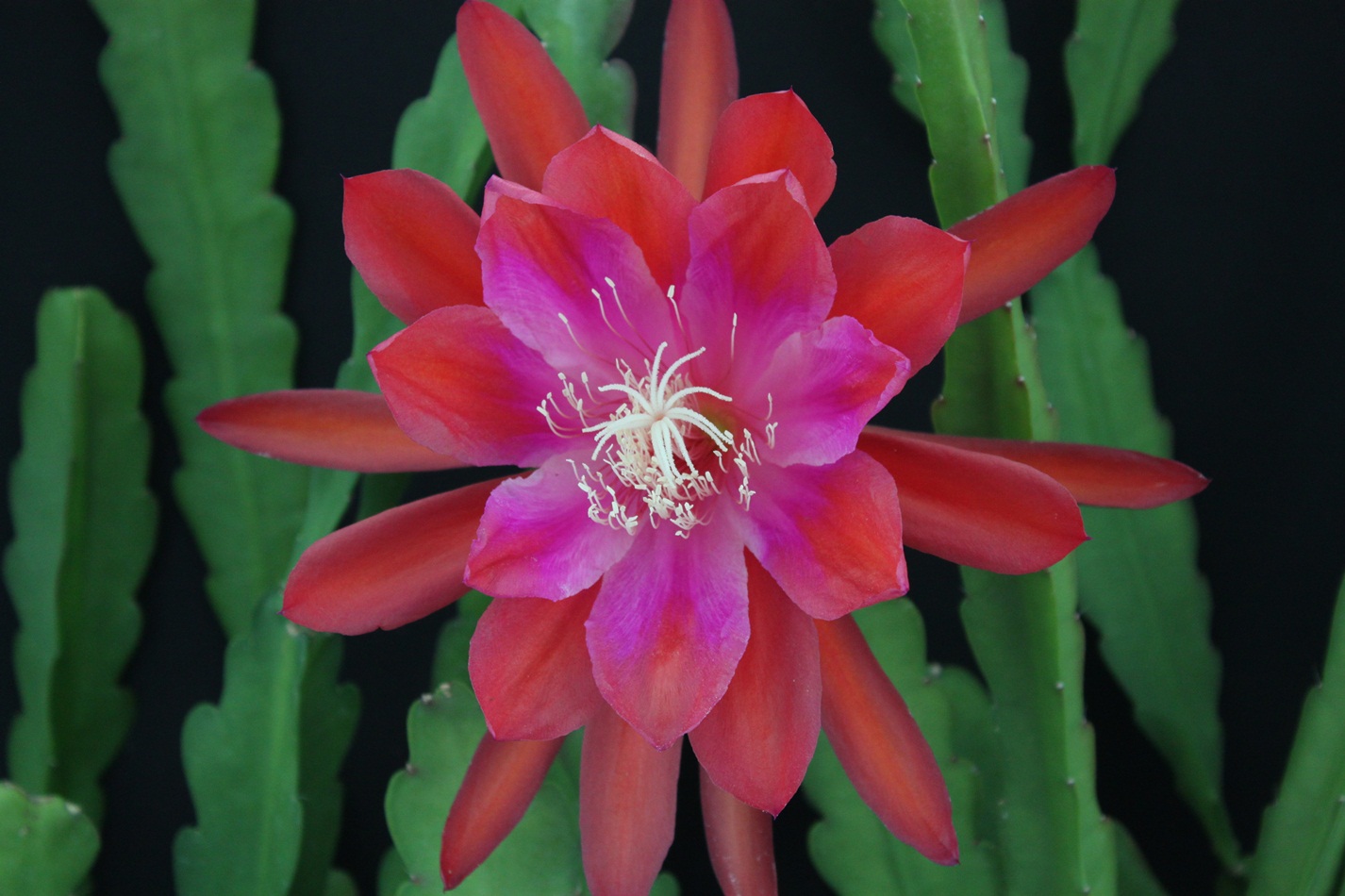
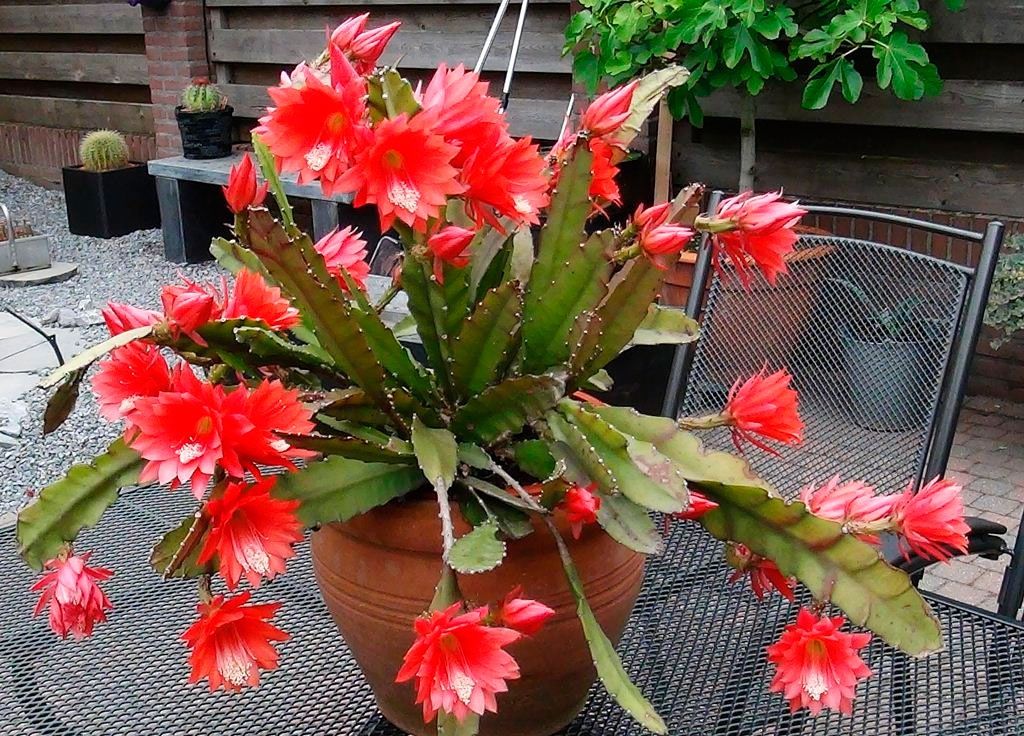


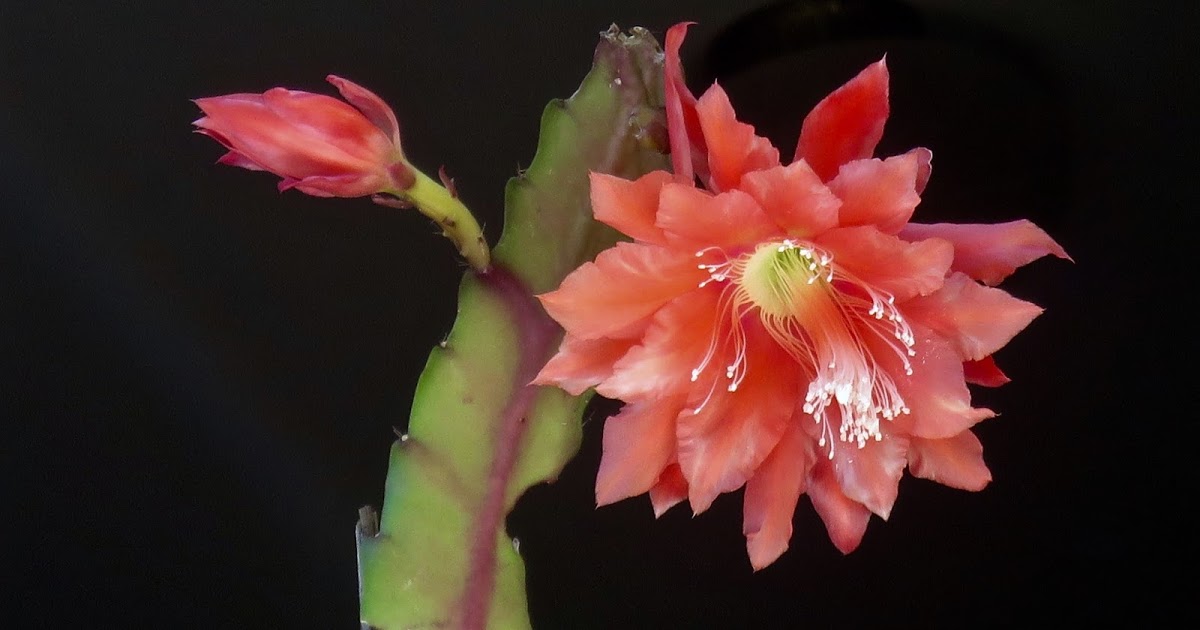
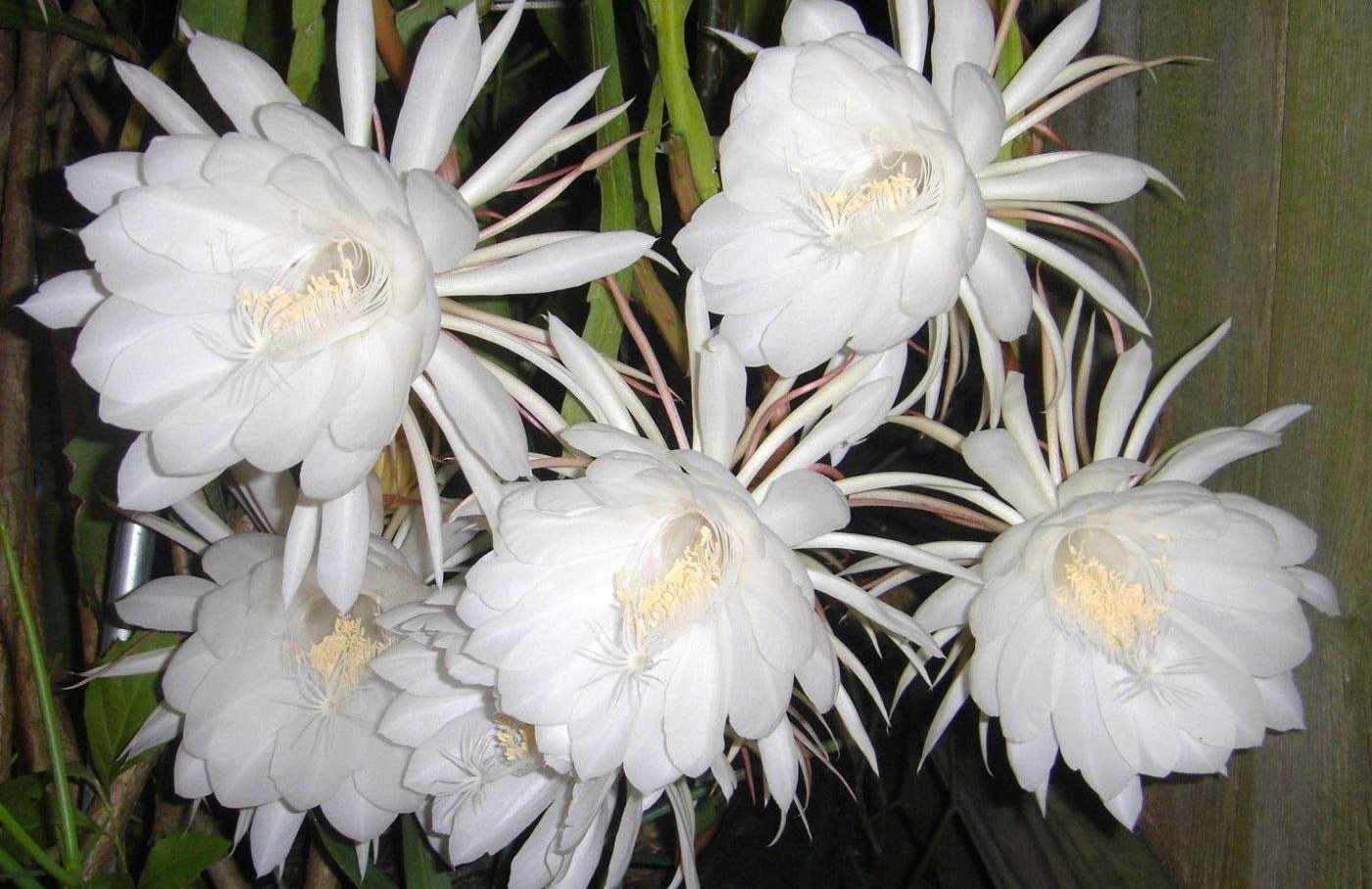
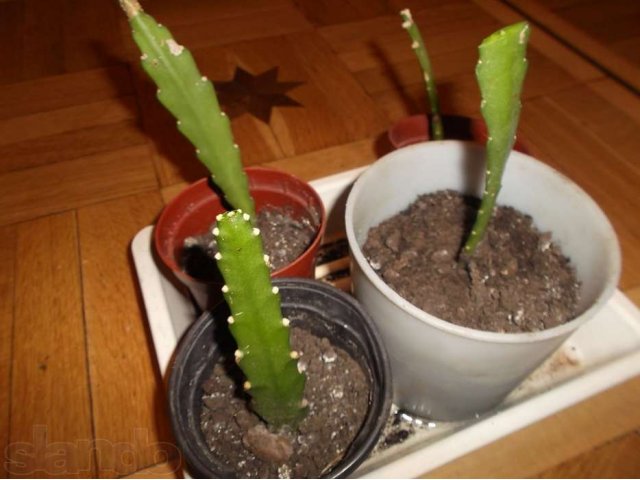

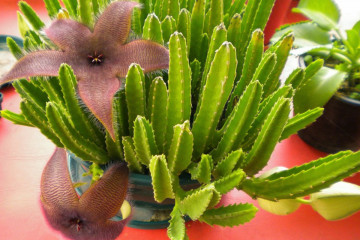


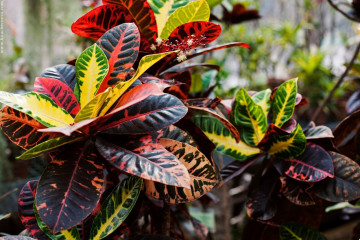











In the article about Ackerman's epiphyllum it is said that they have a trihedral stem shape, and next to it is a photo-flat stem How's that?